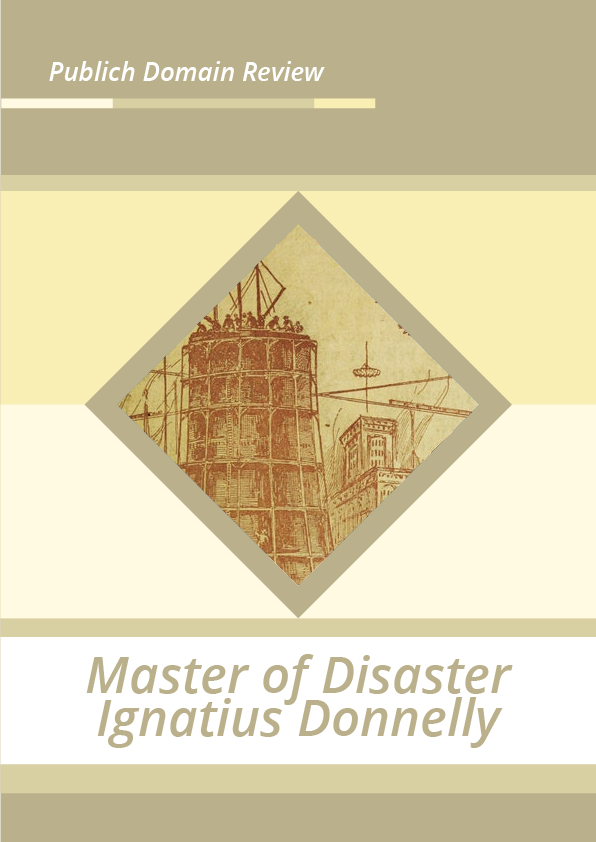The destruction of Atlantis, cataclysmic comets, and a Manhattan tower made entirely from concrete and corpse — Carl Abbott on the life and work of a Minnesotan writer, and failed politician, with a mind primed for catastrophe.
The magnificent civilization of Atlantis shattered and plunged beneath the sea in February 1882. Or, to be more precise, the eccentric American Ignatius Donnelly published Atlantis: The Antediluvian World, the first book of a trio that would highlight a series of imaginary catastrophes. The book — a rehash of Atlantis speculation supported with flood myths from around the globe — was an instant success and has continued to draw readers over the decades. Newspaper reviews were laudatory: Harper and Brothers issued seven printings in the first year, and W. E. Gladstone took time out from pondering the Irish Question to write Donnelly a four-page fan letter.
It was easy to imagine the worst in 1882. President James Garfield had been assassinated only months earlier — the second president shot to death in sixteen years. The economy was dropping into a new recession even as it struggled to emerge from the dark years of the 1870s. Farmers in Donnelly’s state of Minnesota were especially hard hit. In September, thirty thousand New York workers marched in the nation’s first Labor Day parade, remembering the violent railroad strike of five years earlier.
Atlantis might have seemed to offer relief from the turmoil. Its densely packed pages of pseudoscience and mythology recounted the supposed golden age of the lost continent and world-spanning civilization first mentioned by Plato. But the subtext was the fragility of a golden age. When Atlantis sank beneath the waves in a global cataclysm, a powerful and nearly perfect society perished. For Donnelly, Atlantis was a model and mirror for the United States, where urbanization, industrialization, and the accumulation of vast wealth were a social deluge destroying the nation’s own golden age of the agrarian frontier.
It was personal. That mythicized American frontier had promised much to Donnelly and delivered less. He began as an enthusiast who tried to make it as a farmer, land developer, and politician in a nation that seemed to offer unlimited opportunity but was riven by social and economic conflicts. He was also a prickly character. He started out as a lawyer in Philadelphia, but quarrels with clients and family propelled him to Minnesota in 1858, just as it was being admitted as a state. He plunged into land speculation and politics. Nininger City, an undeveloped townsite seventeen miles from St Paul needed only his promotional talents to become a major river port and make Donnelly a rich man, or so he hoped. Alas, few residents came. Readers of Charles Dickens might think of Martin Chuzzlewit’s ill-fated visit to Eden, another Mississippi Valley “city” that never matched its press notices.
Undeterred, Donnelly got in with the new Republican Party and was elected Lieutenant Governor of Minnesota at age twenty-eight: he then served as US Congressman for three terms from 1863–68. Not a man to hold his tongue, however, he split with Republicans because they were becoming conservative, returned to his lonely mansion at Nininger, ran an anti-monopoly newspaper, and tried out a series of third parties and splinter factions, which failed to propel him to the offices he thought he deserved.
Twenty years of personal frustration turned his thoughts toward catastrophe. Reporting on the Dakota War of 1862, in which Sioux tribes struck back at encroaching settlers in western Minnesota, he had seemed to revel in the horrors of war. For a St Paul newspaper he described refugees from the town of New Ulm: “There were mothers there who wept over children slaughtered before their eyes, strong men . . . who had escaped into the grass with the death shrieks of parents, brothers, and sisters, ringing in their ears.”
Those death shrieks were just the start for a writer who came to specialize in cataclysms that could rend entire cities, ravage entire civilizations, or destroy entire continents. As his ambitions and plans repeatedly fell short — his agrarian golden age failed to materialize — he took up his pen to explore increasingly extreme visions of apocalypse. First came “factual” accounts of two very different prehistoric disasters — Atlantis (1882), followed by Ragnarok: The Age of Fire and Gravel (1883) — and then, seven years later, Caesar’s Column: A Story of the Twentieth Century (1890), a futuristic novel that major publishers rejected as dangerously revolutionary.











